Information you will be given on a piece of paper at the time of your exam:
The three templates listed below are especially important for drug information searches
1. Drug A causes Disease B
(“Drug A/adverse effects”[mesh] ) AND (“Disease B/etiology”[mesh])
2. Drug A used to treat Disease B
( “Drug A/therapeutic use”[mesh]) AND (“Disease B/therapy”[mesh] )
3. Drug A used to prevent Disease B
“Drug A”[mesh] AND “Disease B/prevention and control”[mesh]
Notes:
In the templates above a “Drug Class A” heading or a “Procedure A” can replace “Drug A”
PubMed field tags:
| Affiliation [AD]
Article Identifier [AID] All Fields [ALL] Author [AU] Author Identifier [AUID] Book [book] Comment Corrections Corporate Author [CN] Create Date [CRDT] Completion Date [DCOM] Conflict of Interest [COIS] EC/RN Number [RN] Editor [ED] Entrez Date [EDAT] Filter [FILTER] First Author Name [1AU] Full Author Name [FAU] Full Investigator Name [FIR] |
Grant Number [GR]
Investigator [IR] ISBN [ISBN] Issue [IP] Journal [TA] Language [LA] Last Author [LASTAU] Location ID [LID] MeSH Date [MHDA] MeSH Major Topic [MAJR] MeSH Subheadings [SH] MeSH Terms [MH] Modification Date [LR] NLM Unique ID [JID] Other Term [OT] Owner Pagination [PG] Personal Name as Subject [PS] |
Pharmacological Action [PA]
Place of Publication [PL] PMID [PMID] Publisher [PUBN] Publication Date [DP] Publication Type [PT] Secondary Source ID [SI] Subset [SB] Supplementary Concept[NM] Text Words [TW] Title [TI] Title/Abstract [TIAB] Transliterated Title [TT] UID [PMID] Version Volume [VI] |
_________________________________________________________________________________
Review Questions
Please, let me know if you have questions or think one of these questions has been entered incorrectly cmschmidt@unmc.edu, 402-650-5056, Thanks, Cindy
__________________
Section 1. Match the information need – to – the best resource for that need
Please review the distinctives listed in the introduction to this section of the book if you have questions about the answers to #1-18.
______
Nine information needs are listed below, #1-9. Please match each information need with the best resource to meet that need
1.
2.
3.
4.
5.
6.
7.
8.
9.
______
Nine information needs are listed below, #10-18. Please match each information need with the best resource to meet that need
10.
11.
12.
13.
14.
15.
16.
17.
18.
__________________
Section 2. True or False
19.
20.
21.
__________________
Section 3. Questions 22 –25 refer to the “Environmental Exposure”[MeSH] tree show below
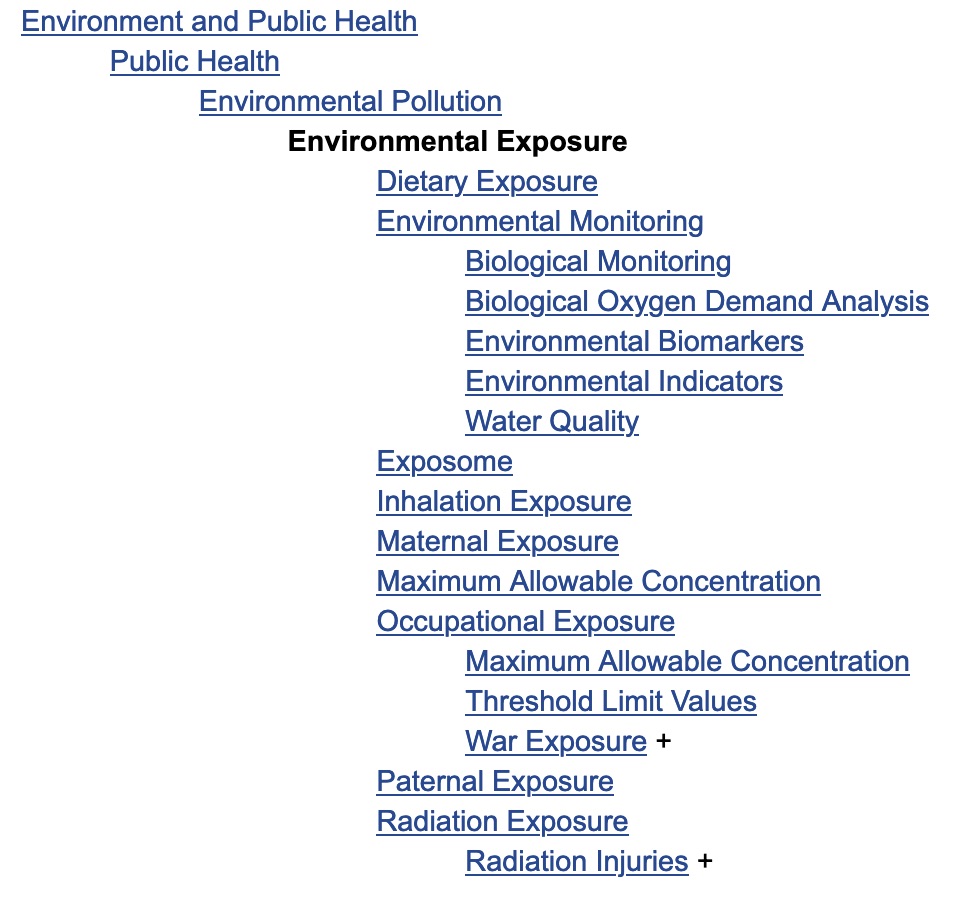
22.
23.
24.
25.
__________________
Section 4. Multiple Choice
26.
27.
28.
__________________
Section 5. Questions 29 -‐-‐ 31 pertain to the following clinical situation
You are rotating through a rheumatology service and have a patient with severe psoriatic arthritis. Her physicians have recommended treatment with one of the monoclonal antibodies that bind TNF and inhibit the action of this protein. TNF is involved in initiating the inflammatory cycle that causes the skin and joint damage seen in psoriatic arthritis (see example of severely affected joints, skin and toenails in the photo below).
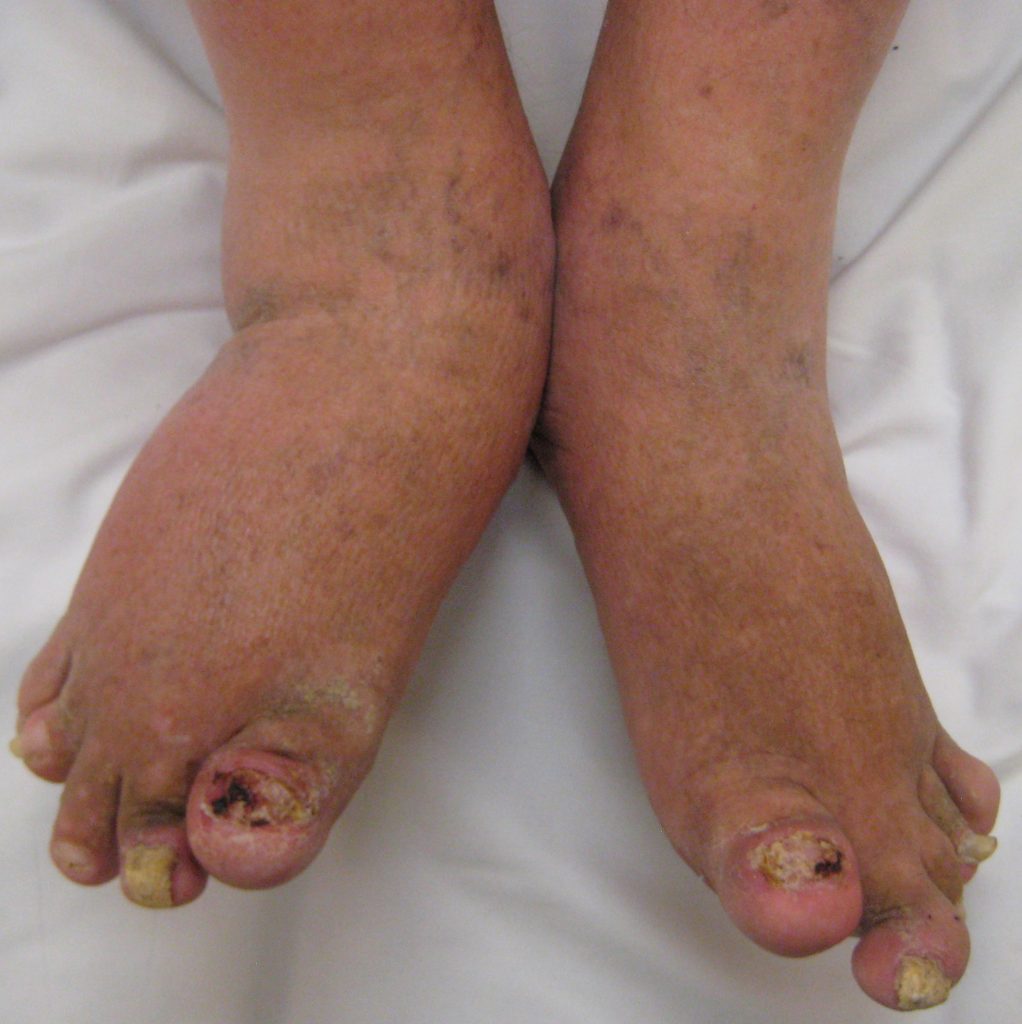
29.
30.
31.
__________________
Section 6. Questions 32 – 37. An upcoming continuing pharmacy education workshop will focus on workplace security and workplace environment. Many students are co-presenting with COP faculty.
32.
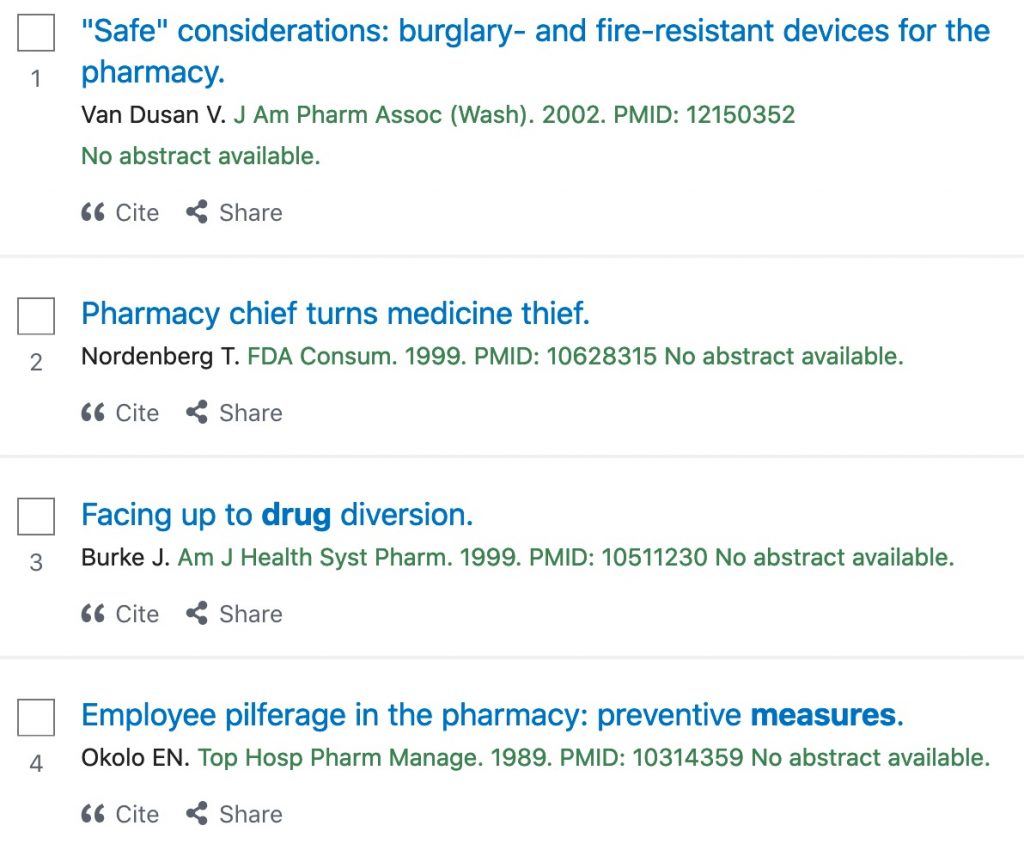
33.
__________________
Section 7. Questions 34 -37. Yet another colleague is preparing a talk on the subject of the civility and political correctness (PC) of pharmacist and pharmacy student communication.
His search is shown below:
(PC OR “politically correct” OR “political correctness” OR polite* OR rude OR rudely OR rudeness OR civility OR harass*OR defam*) AND (pharmacist* OR pharmacy OR pharmacies) AND (communicat* OR discours* OR relation* OR discours* OR conversat* OR speech OR speak* OR talk*)
His search has retrieved over 7,464 results. Few are relevant.
He decides to check the messages above the search results.
![The messages above the search results list including: The following term was not found in PubMed: harass*OR Unknown field was ignored: [all]](https://pressbooks.nebraska.edu/app/uploads/sites/77/2020/07/message-1.jpg)
Next he goes to the “Advanced” page, scrolls down to the “History and Search Details” table, clicked on the arrow in the “Details” column, and scrolled down to find the “Translations”
![Screenshot of the translations which include: Translations PC: "prevention and control"[Subheading] OR ("prevention"[All Fields] AND "control"[All Fields]) OR "prevention and control"[All Fields] OR "pc"[All Fields] rudeness: "incivility"[MeSH Terms] OR "incivility"[All Fields] OR "rudeness"[All Fields] civility: "civil"[All Fields] OR "civility"[All Fields] OR "civilization"[MeSH Terms] OR "civilization"[All Fields] OR "civilizations"[All Fields] OR "civilization's"[All Fields] OR "civilized"[All Fields] OR "civilizing"[All Fields] OR "civils"[All Fields] pharmacy: "pharmacie"[All Fields] OR "pharmacies"[MeSH Terms] OR "pharmacies"[All Fields] OR "pharmacy"[MeSH Terms] OR "pharmacy"[All Fields] OR "pharmacy's"[All Fields] pharmacies: "pharmacie"[All Fields] OR "pharmacies"[MeSH Terms] OR "pharmacies"[All Fields] OR "pharmacy"[MeSH Terms] OR "pharmacy"[All Fields] OR "pharmacy's"[All Fields] speech: "speech"[MeSH Terms] OR "speech"[All Fields] OR "speech's"[All Fields] OR "speeches"[All Fields]](https://pressbooks.nebraska.edu/app/uploads/sites/77/2020/07/translations-1024x958.jpg)
34.
35.
36.
37.
__________________
Section 8. When answering questions 38, consider the MeSH database entry for the “Kounis syndrome” heading (see screenshot below):
38.


__________________
Section 9. Use the search history table shown below to answer question 39 and question 41.
You’ve been asked to review the literature about the attitudes of health professionals and the attitudes of health professions students toward substance abuse.
| Search # | Query | Items found |
|---|---|---|
| #85 | Search “Pharmacy Technicians/psychology”[Mesh] | 30 |
| #84 | Search “Pharmacists/psychology”[mesh] | 792 |
| #83 | Search “Students, Pharmacy/psychology”[mesh] | 365 |
| #82 | Search “Attitude of Health Personnel”[mesh] | 115313 |
| #81 | Search “Substance-Related Disorders”[mesh] | 352656 |
39.
40.
41.
__________________
Section 9. Answer question 42 using the information below from a source that provides the various types of drug names needed for an exhaustive search.
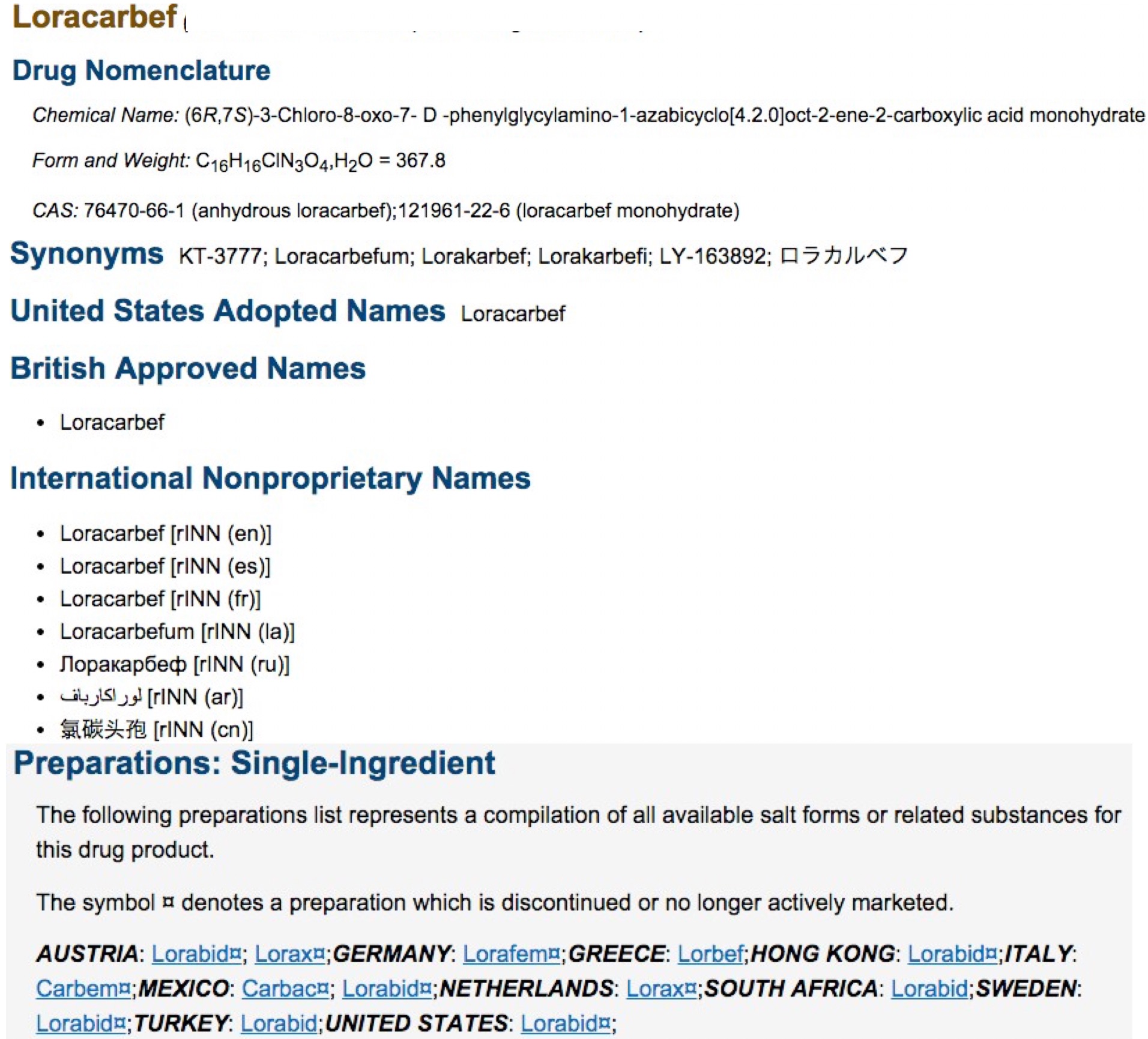
Your friend has created the search strategy:
(loracarbef* OR Lorakarbef* OR “LY-163892” OR LY163892 OR 121961-22-6 OR 76470-66-1 OR Carbac[tiab] OR Carbem[tiab] OR Lorabid[tiab] OR Lorax[tiab] OR Lorbef[tiab] Lorafem[tiab])
__________________
Section 10. Question 43
43. You’re interested in errors seen when computerized order entry systems are used. You have created a search strategy. The MeSH tree for “Medical Errors”[MeSH] , the search strategy you created, and the citation information and subject headings from three PubMed records are shown below. Which of the three records will your search retrieve (#1, #2, #3, all (1,2 and 3), or none)
MeSH tree:
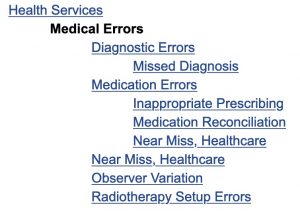
Search Strategy: “Medical Order Entry Systems”[MeSH] AND “Medication Errors”[MeSH]
| Record #1 | Record #2 | Record #3 |
|---|---|---|
| Arch Intern Med. 2011 Mar 14;171(5):473-4;
Time to change the paradigm–from “potentially inappropriate” to real patient harms |
Int J Clin Pharm. 2011 Aug;33(4):603-9.
Developing a programme for medication reconciliation at the time of admission into hospital |
Pediatrics. 2013 Jun;131(6):e1948-9.
Time for Alert-ology or RE-sensitization? |
|
|
|
| Confused? Watch this video to see how to go about answering #43. | 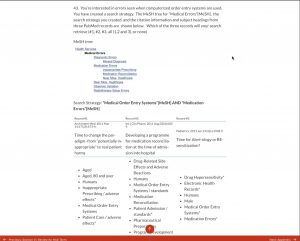 |
__________________
Section 10. Question 44.
44. You run a Google Scholar search for:
intitle:naltrexone 1..5 mg fibromyalgia
Which of the following Google Scholar hits would be retrieved by this search? (a,b,c,d, or all (e))?
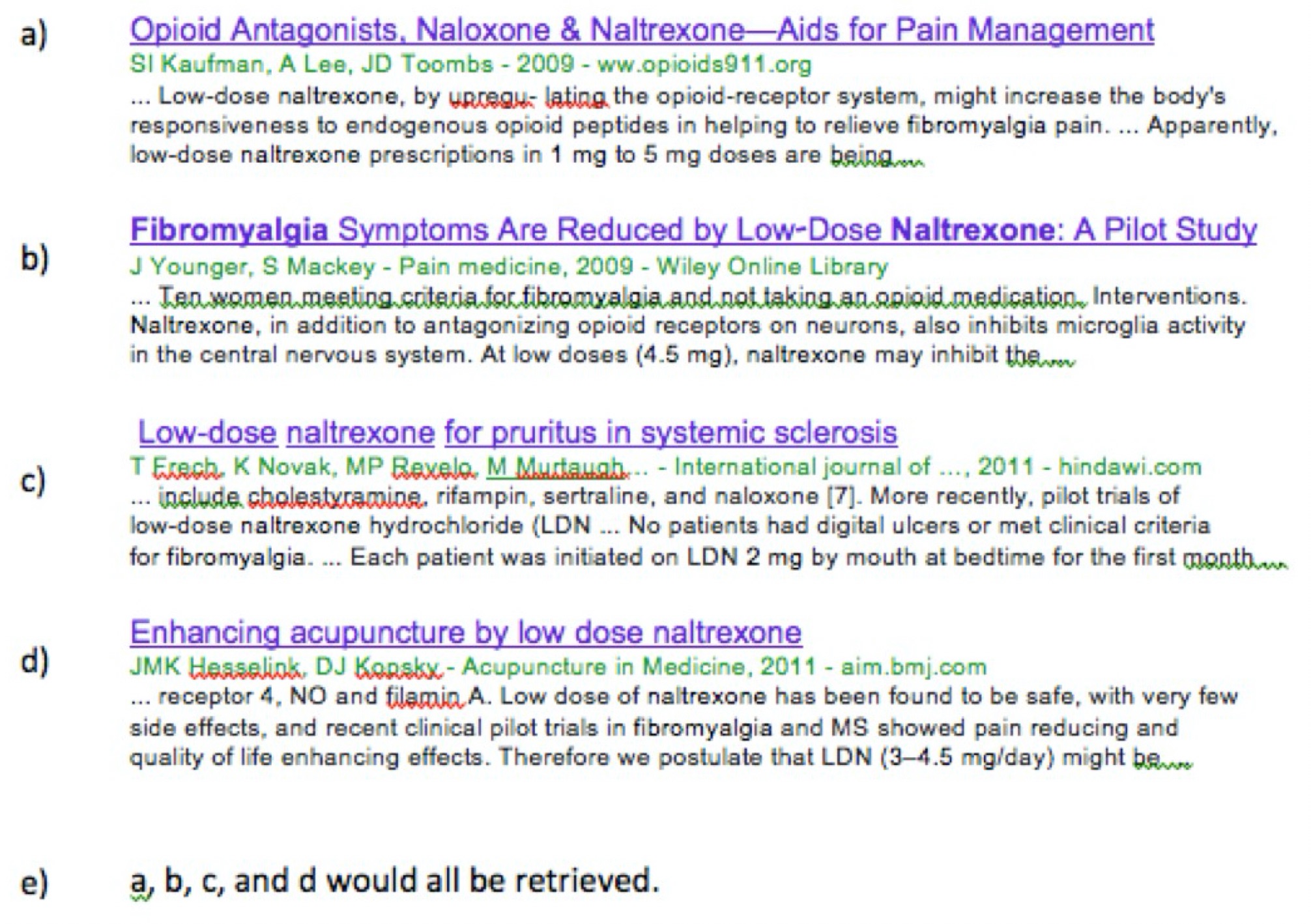
__________________
Section 11. Question 45.
45. You’ve been asked to obtain a copy of the full-text of the following article:
Yanamadala M, Heflin MT, White HK, Buhr GT. Ensuring vitamin D supplementation in nursing home patients–a quality improvement project. Journal of Nutrition in Gerontology and Geriatrics. 2012;31(2):158-71.
You find the following entry in the Library’s catalog:

_________________________________________________________________________________
Questions, Problems, Text Errors?
Before you leave, …
- Do you have any questions or do you feel that clarification of some aspect of the materials would be helpful?
- Have you noticed any errors or problems with course materials that you’d like to report?
- Do you have any other comments?
If so, you can submit questions, comments, corrections, and concerns a to Cindy Schmidt at cmschmidt@unmc.edu.

